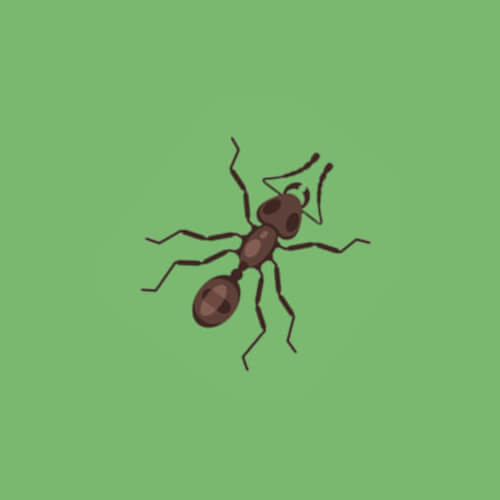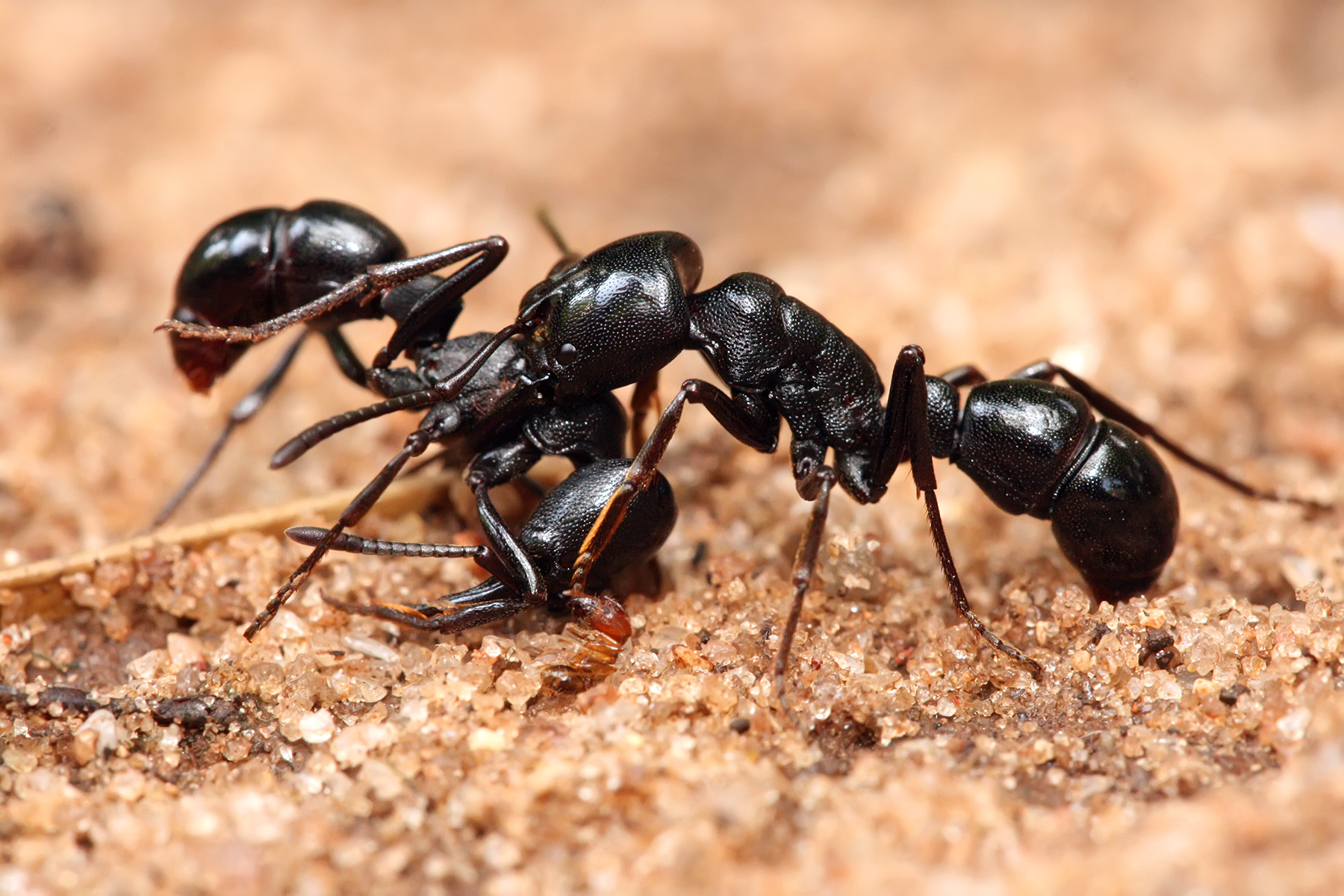


| Kingdom: | Animalia |
| Phylum: | Arthropoda |
| Class: | Insecta |
| Order: | Hymenoptera |
| Family: | Formicidae |

Ants are insects from the Formicidae family. Ants are related closely to wasps and bees, and it's estimated that ants evolved from a wasp-like ancestor about 140 million years ago! Scientists believe that there are about 22,000 species of ants, but there have only been 12,500 species classified so far. Like all insects, ants have three distinct body regions: a head, thorax (the middle section), and abdomen (the rear section), and have two long antennae.
Ants are highly social insects that live in organized colonies, often in an elaborate maze of underground tunnels. Each colony consists of a queen, female workers, and, in some species, male drones. The queen's primary role is to lay eggs and ensure the survival of the colony. Female worker ants take on various tasks, such as foraging for food, caring for the young, and defending the nest. They exhibit impressive division of labor and communicate through chemical signals called pheromones.
Ant colonies can be thought of as superorganisms, where the collective behavior of individual ants leads to the overall success of the colony. Through complex systems of communication and cooperation, ants demonstrate remarkable problem-solving abilities, such as finding the shortest routes to food sources or defending against threats. Their coordinated efforts and selflessness serve as an inspiration for scientists studying swarm intelligence and cooperative behavior in other complex systems.
Ants can be found on every continent except Antarctica, showcasing their impressive adaptability to various environments. They occupy a wide range of habitats, including forests, grasslands, deserts, and even urban areas. The diverse species of ants exhibit a remarkable array of sizes, colors, and behaviors. From the tiny and elusive leaf-cutter ants to the fierce and predatory army ants, each species has unique characteristics that contribute to the intricate tapestry of the ant world.
Ants play a crucial role in ecosystems as ecological engineers. They are diligent scavengers and predators, contributing to nutrient recycling and regulating populations of other organisms. Some ant species form mutualistic relationships with plants, aiding in seed dispersal and promoting plant growth. Their elaborate underground tunnels and nests can aerate soil and enhance its fertility. These tiny architects shape their surroundings in ways that have far-reaching effects on the environment.
Ants have strong, jointed legs that allow them to carry heavy loads, and their exoskeleton, or outer shell, provides extra support. They also have powerful mandibles, or jaws, that can grasp onto objects and hold them firmly in place. Because of these traits, entomologists estimate that ants can lift anywhere from 50-100 times their body weight.
One study published in the Journal of Experimental Biology found that the Asian weaver ant Oecophylla smaragdina can lift objects up to 100 times their own body weight using their jaws. Similarly, the leafcutter ant Atta cephalotes can carry up to 50 times their own body weight, according to a study published in the journal Insectes Sociaux.
Ants have small holes in their bodies called spiracles that allow air to enter and exit. Through these spiracles, ants are able to take in oxygen, which they need to help their cells produce energy. They also release carbon dioxide, which is a waste product of cellular respiration. The spiracles are located all over the ant's body, including on the thorax and abdomen, and are connected to a network of tubes called tracheae.
This system of air exchange allows ants to breathe without needing lungs, which would be too heavy and bulky for their small bodies. It also allows them to be more efficient in their use of oxygen, which is important for insects that have high energy demands.
Because the queen ant is the only ant that can lay eggs and create new ants, she is essential to the survival of the entire colony. If the queen ant dies, the colony may survive for a few months, but it will eventually collapse. Without her, the colony cannot produce new workers or soldiers, and it will eventually die off. It's lucky then, that queen ants can often live for many years.
In some species of ants, such as the leafcutter ant, the queen ant can weigh up to 50 times more than the worker ants. She is also usually the largest ant in the colony and is often protected by the workers and soldiers. Overall, queen ants are a crucial part of ant colonies and play an important role in the survival and reproduction of their species.
A recent study published in the Journal of Experimental Biology found that Saharan silver ants, Cataglyphis bombycina, are capable of running at a speed of 0.855 meters per second, which is about 108 times their body length per second. Cheetahs on the other hand, the fastest land animal, can only run at about 16 body lengths per second.
Ants are able to run incredibly quickly because of their small size and the unique structure of their legs. Their legs are very strong and can move rapidly, allowing them to cover a lot of ground in a short amount of time. Some species of ants are even able to run upside down on smooth surfaces, which is an impressive feat.
Ants don't have ears and instead use their legs to detect vibrations in the ground. They have special hairs called "sensilla" on their legs and feet that are sensitive to vibrations, allowing them to "hear" their environment. This unique characteristic of ants enables them to hear threats, locate food, and even communicate with each other.